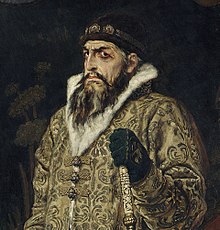Polish–Lithuanian–Muscovite Commonwealth
This article needs more sources for reliability. |
The Polish–Lithuanian–Muscovite Commonwealth, also known as the Triple Union in Polish (unia troista) was a proposed union between the Tsardom of Russia and the Polish-Lithuanian Commonwealth. Most of the propositions were made between 1574 and 1658. The union was rejected by one or both sides at various times because they didn't want a union.

History[change | change source]
Polish succession[change | change source]

The first proposal of the union was made in the 16th century, when the last king of the then ruling Polish Jagiellon dynasty died. Many people in the Polish-Lithuanian Commonwealth wanted the Commonwealth to be ruled by Tsar Ivan IV of Russia ("the Terrible"). Ivan offered to decrease the power of the Polish-Lithuanian magnates (high nobility in the Polish-Lithuanian Commonwealth). Two diplomatic missions were sent from Poland to Moscow, which both failed due to the two sides not being able to agree on a compromise. This was due to the earlier Livonian War (where the Tsardom fought the Commonwealth) and Tsar Ivan's demands of the former territory of Kievan Rus, which Lithuania held. Eventually, negotiations were dropped, and the pro-Ivan faction in the Commonwealth agreed to stop supporting Ivan in becoming the king.[1]
Russian succession[change | change source]

The second proposal was made after the death of Tsar Ivan, as Feodor I was made Czar of Russia. After the Polish king's death, Feodor sent a diplomatic mission to the Polish-Lithuanian Commonwealth. The Lithuanians supported him, but Poland asked for things such as Feodor becoming a Catholic, which the Tsar did not want to do. After the next Polish king was elected, Sigismund III Vasa, he asked to become the Tsar of Russia. However, by the time the proposal made it to Moscow, a new Tsar took control of Russia.
After this, Russia entered the Time of Troubles. Because of this, the Polish-Muscovite War began between the Commonwealth and the Tsardom. While this war secured Russian independence, it also had Russia give up some territories to Poland-Lithuania. Because of the war, Władysław IV Vasa, a Polish prince, (unofficially) became Tsar of Russia for a short period of time.
Last Proposal[change | change source]
The last proposal by the Tsardom would be made in the Russo-Polish War of 1654, where the union would be a part of the treaty. The Polish, however, gave demands that the Russians did not accept. These once again included things such as the Tsar becoming Catholist, as well as territorial changes this time.
Related pages[change | change source]
- Congress Poland, the Polish-Lithuanian Commonwealth as part of Russia
References[change | change source]
- ↑ Jerzy Malec, Szkice z dziejów federalizmu i myśli federalistycznych w czasach nowożytnych, "Unia Troista", Wydawnictwo UJ, 1999, Kraków, ISBN 83-233-1278-8.
